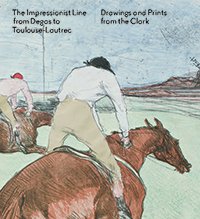
NOVEMBER 5, 2017–JANUARY 7, 2018
HENRI DE TOULOUSE-LAUTREC
Henri de Toulouse-Lautrec (French, 1864–1901)
Dance at the Moulin Rouge, 1897
Color lithograph on paper
Clark Art Institute, 1962.119
Born into an aristocratic family, Henri de Toulouse-Lautrec (1864–1901) immersed himself in art from a young age, in part because of frequent, isolating childhood illness and limited mobility caused by a genetic condition that stunted his growth. As an adult, Toulouse-Lautrec joined kindred spirits in the creative, bohemian district of Montmartre, a hillside working-class village annexed by Paris during the city’s vast public works renovations of the mid-nineteenth century. The neighborhood welcomed artists, writers, performers, and pleasure-seekers from all strata of society into its cafés, dancehalls, brothels, and boisterous cabarets. As a participant in and astute observer of Montmartre’s vibrant nightlife, Toulouse-Lautrec found artistic subjects in can-can dancers, actresses, singers, prostitutes, and fellow barflies.
In the late 1880s Toulouse-Lautrec embraced the medium of lithography. He developed a distinctive graphic style that won him regular commissions to produce posters advertising performers and entertainment venues, including the Moulin Rouge. Emboldened with bright and broad swaths of color and swift, expressive contour lines that create a heightened sense of movement, his posters adopted stylistic and compositional qualities of Japanese ukiyo-e prints. The artist often used the crachis (French for “spit”) technique of spattering ink onto the lithographic stone’s surface to create atmospheric mists of color. Though Toulouse-Lautrec did not align himself with any particular school of artists, his inventive prints added to the visual vocabulary associated with Post-Impressionism, an art movement less interested in naturalism and detail but more focused on the qualities of abstraction that would later become a hallmark of twentieth-century art.
A fully illustrated catalogue, edited by Jay A. Clarke, accompanies the exhibition. The 160-page catalogue includes essays by Mary Weaver Chapin, Jay A. Clarke, Anne Higonnet, Richard Kendall, and Alastair Wright. The catalogue is published by the Clark and distributed by Yale University Press. Call the Museum Store at 413 458 0520 to order.


